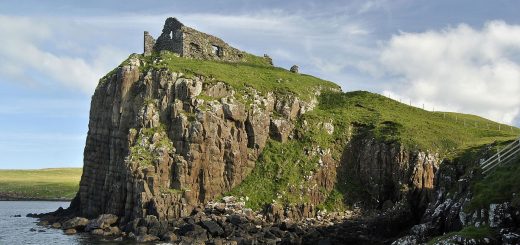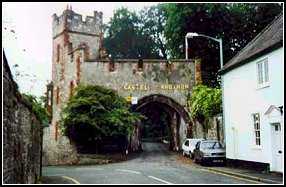The Griffin
The Griffin, built in 1679 was one of the first ships to sail on the Great Lakes and was used by the French Rene-Robert Cavelier, Sieur de La Salle ( 22 November 1643 – 19 March 1687), to explore that part of Northern America. The ship was however lost with all hands within a few months, though reputedly her ghostly apparition has been seen many times over the centuries since she vanished without a trace.
 The exact location where the Griffin was built is probably open to debate, though it is generally believed to be around Cayuga Creek, in Niagara, New York State. She was commissioned by La Salle who spent most of the building period in Fort Frontenac, leaving his two associates Father Louis Hennepin and Henri de Tonti to construct the vessel. The Griffin measured between 40’ and 60’ in length and was about 18’ wide. She was considered to be between 40 and 60 tons and described as having a single mast. All the timber for the vessel was cut and prepared on site but the difficult to craft items, such as sails, rigging, anchor and her guns were brought in from elsewhere. One account described the ship as; “The vessel was sixty tons burthen, completely rigged, and found with all necessaries, arms, provisions and merchandise; besides seven pieces of cannon, two of which were of brass. There was a griffin flying at the jib-boom and an eagle above, and the other ornaments that were used to grace a ship of war.”
The exact location where the Griffin was built is probably open to debate, though it is generally believed to be around Cayuga Creek, in Niagara, New York State. She was commissioned by La Salle who spent most of the building period in Fort Frontenac, leaving his two associates Father Louis Hennepin and Henri de Tonti to construct the vessel. The Griffin measured between 40’ and 60’ in length and was about 18’ wide. She was considered to be between 40 and 60 tons and described as having a single mast. All the timber for the vessel was cut and prepared on site but the difficult to craft items, such as sails, rigging, anchor and her guns were brought in from elsewhere. One account described the ship as; “The vessel was sixty tons burthen, completely rigged, and found with all necessaries, arms, provisions and merchandise; besides seven pieces of cannon, two of which were of brass. There was a griffin flying at the jib-boom and an eagle above, and the other ornaments that were used to grace a ship of war.”
The construction of the vessel brought mixed opinions from the local Native American tribesman. Though the chiefs of the Seneca tribe allowed the Griffins construction, some of the tribe were not happy and according to Hennepin “expressed some discontent”. He went on to suggest that the French workmen did all they could to finish the ship quickly “. . to prevent the designs of the natives, who had resolved to burn it.” A prophet of the Iroquois Indians claimed the Griffin was created to destroy the Great Spirit and is said to have cursed the vessel, claiming it would then sink should they try to sail her. However, the launch of the Griffin went without a hitch. A volley was fired from the ships guns and there were great celebrations which the Seneca and Iroquois Indians joined in, especially as they were given some brandy by the French.
 On 7th August 1679 La Salle set sail with Father Hennepin, a pilot and roughly 30 others. Tonti and his advanced party were picked up as they entered the Detroit River on 11th August. Tonti was to leave the Griffin mid journey to hunt down some French deserters they discovered in a village. The journey was not by all accounts easy, but they managed to reach Winconsin. The Griffin was then loaded with furs for her return journey to his storehouse above the falls at Niagara on 18th September 1679. Those furs would then be sent to Fort Frontenac to appease La Salles creditors. La Salle and his men decided however not to return with the Griffin and instead take canoes further in country searching for a link to the Mississippi River. The Griffin set sail from Washington Island with a cargo worth about 60,000 livres with instructions to stop off at Mickili-mackinac before heading for Niagara. She was commanded by Luc (or Luke the Dane) the pilot and a crew of five others. She gave a single gun salute as she headed out and was never heard from again.
On 7th August 1679 La Salle set sail with Father Hennepin, a pilot and roughly 30 others. Tonti and his advanced party were picked up as they entered the Detroit River on 11th August. Tonti was to leave the Griffin mid journey to hunt down some French deserters they discovered in a village. The journey was not by all accounts easy, but they managed to reach Winconsin. The Griffin was then loaded with furs for her return journey to his storehouse above the falls at Niagara on 18th September 1679. Those furs would then be sent to Fort Frontenac to appease La Salles creditors. La Salle and his men decided however not to return with the Griffin and instead take canoes further in country searching for a link to the Mississippi River. The Griffin set sail from Washington Island with a cargo worth about 60,000 livres with instructions to stop off at Mickili-mackinac before heading for Niagara. She was commanded by Luc (or Luke the Dane) the pilot and a crew of five others. She gave a single gun salute as she headed out and was never heard from again.
The fate of the Griffin is a mystery. Father Hennepin thought it had been destroyed in a storm as he stated here; “It came to anchor at the mouth of Lake Illinois, where it was seen by some savages, who told us that they advised our men to sail along the coast, and not toward the middle of the lake, because of the sands that make the lake dangerous when there are high winds. Our pilot, as I said before, was dissatisfied, and would steer as he pleased without hearing to the advice of the savages, who, generally speaking, have more sense than the Europeans think at first. But the ship was hardly a league from the coast when it was tossed up by a violent storm in such a manner that our men were never heard from since; and it is supposed that the ship struck on the sand, and was there buried.”
 La Salle (right) came to believe that the pilot and the crew had scuttled the ship and headed off with the goods in canoes. In 1683 he wrote a letter claiming one of his Indians described a white man being held a prisoner by a distant tribe. This man fitted the description of the pilot and was supposed to have been captured with four other men and canoes filled with furs. They were heading in the direction of the Sioux Indians when caught.
La Salle (right) came to believe that the pilot and the crew had scuttled the ship and headed off with the goods in canoes. In 1683 he wrote a letter claiming one of his Indians described a white man being held a prisoner by a distant tribe. This man fitted the description of the pilot and was supposed to have been captured with four other men and canoes filled with furs. They were heading in the direction of the Sioux Indians when caught.
There was also the possibility that the ship was boarded and sank by Indians, as a small six man crew may not have been able to fight off an attack.
In the early 1900’s the Light House Keeper on Manitoulin Island found some skeletons in a cave and Frederick Stonehouse a maritime historian suggested they may have been the crew of the Griffin.
The remains of a vessel that could be the Griffin were discovered near Buffalo and a letter was published by The Buffalo Commercial Advertiser on 26 January 1848. The letter, by Mr James Peters stated “Some thirty-five or forty years ago, on the Ingersoll farm, in Hamburg, below the Eighteen-mile creek, and on a high bank in the woods, was found by Mr. Ingersoll a large quantity of wrought iron, supposed to be 700 or 800 weight. It was evidently taken off a vessel, was of superior quality, much eaten by rust, and sunken deep in the soil. A large tree had fallen across it, which was rotted and mixed with the earth. There were trees growing over the iron from six to twelve inches in diameter, which had to be grubbed up before all the iron could be reached. About twenty-seven years since, a man by the name of Walker, after a heavy blow on the lake, found on the beach, near where the irons were found, a cannon, and immediately under it a second one. I was there not forty-eight hours after they were found; they were much defaced by age and rust, and filled up with sand. I cleared off enough from one to lay a number of letters bare. The words were French and so declared at the time. The horns or trunnions were knocked off.”
Whatever the true fate of the Griffin, her disappearance has become an enigmatic mystery. However, does she truly haunt the Great Lakes? I’m not really sure to be honest. I have come across several books referring to this ghost ship but none give any witness accounts, which leads me to think this haunting may more to do with the legend of the vessel and local folklore than any actual genuine experiences.
As always, if you know more, please leave your comments below.




Recent Comments